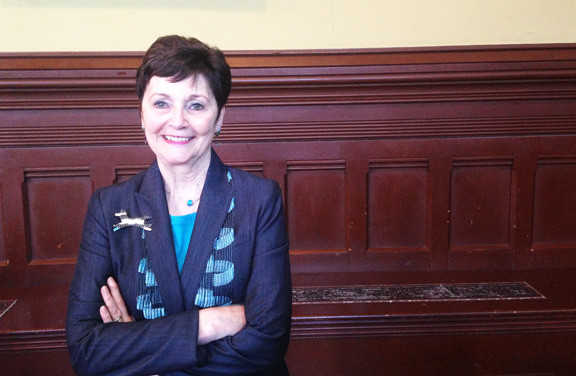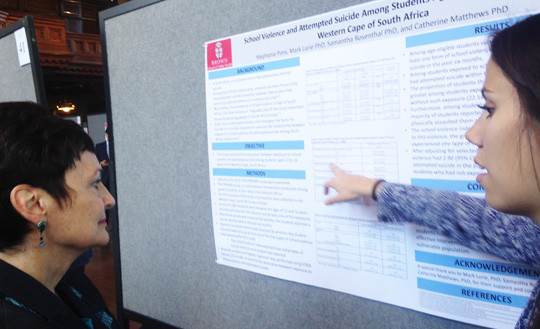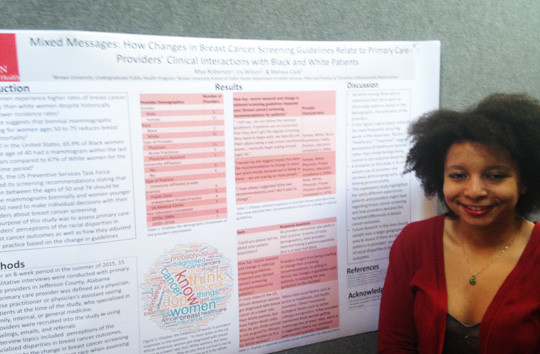On the front lines of public health research
Public Health Research Day provides a broad lens to look at public health and advocacy
We are still trying to adjudicate the cleanup of PCBs decades later after their health hazards became incontrovertible; a few weeks after GE announced its decision to move its corporate headquarters to Boston, Mass., it rejected the latest proposed settlement efforts to clean up the PCB mess left behind by its manufacturing facility in Pittsfield. We are still reeling from the ravages of opioid addiction delivered to us by drug manufacturers; we are learning more about the long-term dangers of PFOA, a chemical used in the manufacture of Teflon, and its prevalence and threat to human health.
Although the dangers of lead in paint and in water pipes have been well-documented, we are still wrestling with the economic burden of cleaning it up to prevent it poisoning children and families.
And, as many of the nuclear power plants built in the 1960s and 1970s are taken off line and decommissioned, no longer safe to operate, we are about to learn the dire truths about the dangers of nuclear waste stored at those facilities and their long-term economic and health impacts. Too cheap to meter?
Many politicians decry what they term as over-regulation when it comes to environmental and health threats. Many of those same politicians offer stiff-necked resistance and denial about the man-made causes of climate change and global warming, as if the chanting of shibboleths about free enterprise can hold back the oceans’ rising tides.
The reality is that we need a new kind of consumer environmental movement to be reborn, 46 years after the first Earth Day, one that translates public advocacy into effective political action, focused on public health.
PROVIDENCE – The 2016 Public Health Research Day, held on April 13 at Sayles Hall by the Brown University School of Public Health, was a chance to view 66 research posters by some of the best and brightest students at Brown and their data-driven analysis of health quandaries facing Rhode Island, the nation and the world.
Most if not all of the research posters tackled topics that delved into controversial public policy issues: Mya Roberson, a Brown undergraduate, looked at “Mixed messages: How changes in breast cancer screening guidelines relate to primary care providers’ clinical interactions with black and white patients.
Roberson chose Birmingham, Ala., as her geographic focus, because it was a majority black city. And, as she told ConvergenceRI, her hypothesis kept changing, in an iterative manner, the more she dug deeper into her research. One of her surprising findings was that access to mammograms and screenings did not divide along racial lines; black women actually had higher rates of mammograms than white women in Birmingham.
Roberson’s research poster was not one of those chosen for an award, but she will be continuing her academic career, studying in graduate school to become an epidemiologist.
Another research poster, “A comparison of the association between prenatal organophosphate pesticide exposure and autistic behaviors in children, based on the PON1 genotype, by Marisa Millenson, which examined the relationship between prenatal pesticide exposure and autistic behaviors in eight-year-old children, did win an award.
It’s probably a research topic that the new Hassenfeld Child Health Innovation Institute, with one of its initial focuses on autism, may want to explore further.
A sampling of the research posters provided a glimpse into kinds of questions being posed by public health research today: “Girl talk: A smartphone application to teach sexual health education to adolescent girls,” by Alexandra Sepolen; “The association between alcohol use, sexual risk behaviors, and HIV in Nigeria: A systematic review and meta-analysis, 1997-2014,” by Uzo Okoro [an award winner]; “The definition of chronic homelessness: Applications and implications for policy and practice,” by Elizabeth Bunzli; “Rhode Island Violent Death Reporting System,” by Yongwen Jiang; “Plasma phospholipod fatty acid and coronary heart disease risk,” by Qing Liu; and “Cigarette smoking and risk of incident rosacea in U.S. women,” by Suyun Li.
A voice for public health
At the end of the event, after the awards had been given out, ConvergenceRI spoke with Terrie Fox Wetle, MS, Ph.D., dean of the School of Public Health at Brown University. The relatively new addition to the university is anticipating it will receive its official accreditation in June.
In Rhode Island, who was the voice, the advocate for public health, ConvergenceRI asked.
“We consider it an important part of what we do, translating the research into policy impact, and also communication with the public,” Wetle said. “We have recruited faculty who have expertise in learning how to help to teach people how to communicate with populations.”
Wetle continued: “I teach a course in qualitative methods, where we [have] a lot of discussion about how to effectively communicate with special populations, particularly vulnerable populations, who may have different levels of education and experience, [such as] immigrants who have a different culture.”
Part of the problem, Wetle explained, is that there is often too much information, not all of it accurate. “I think it’s something that we always struggle to do better because, particularly today, the public is awash with information, not all of which is high-quality, not all of which is evidence-based.”
Wetle acknowledged that translating research into policy could often be a difficult task. “Part of what we do is to [try and] figure out: how do we effectively talk with the public, or with policymakers, or with practitioners about our findings; we’re not always good at it.”
Wetle voiced tentative support for the potential to have the newly created Hassenfeld Child Health Innovation Institute look into creating a broader platform around toxic stress, something that had been suggested by neuroscience researchers Dima Amso and Audrey Tyrka, at the “Brains in Crisis” the week before. [See links to ConvergenceRI stories below.]
“Dr. Phyllis Dennery [pediatrician-in-chief at Hasbro Children’s Hospital] actually just gave a talk last week, and part of it was on toxic stress,” Wetle said. “I think it is an incredibly important topic. It’s one of those topics that we can look at the basic biochemical side, measures of chemicals in the body that are markers of stress; we can look at risk factors for stress, [such as] poverty, or family violence, or disrupted families or child abuse. We can also look at the outcomes of that, and the level of examination is very, very important for those issues.”
There also needed to be a way to translate the issue of toxic stress to the public, Wetle continued.
“When you are talking about mitochondrial differences [in DNA, as a result of toxic stress, the focus of Tyrka’s research], “that’s hard to communicate to the public,” Wetle said.
“But, you might be able to say, ‘Stress actually changes our bodies, and it doesn’t just change our bodies for the moment. When were under stress, when we are sweating or we have a stomach ache, it changes our bodies for years and years to come.’”
Would it be a good idea to convene a meeting at the Hassenfeld Child Health Innovation Institute to consider how to broaden the current agenda to include toxic stress?
“Well, I’m not an expert in toxic stress,” Wetle answered. “One of the things we’re interested in is how do we continue to broaden the agenda of the Hassefeld Institute. We’ve begun, as you know, with three primary [areas of] focus: on autism, asthma and healthy weight, preventing obesity.”
Toxic stress may be one of those next areas the Institute will be able to look at, Wetle said.
Who advocates on behalf of public health?
ConvergernceRI also got a chance to talk with Dr. Patrick Vivier, director of General Pediatrics and Community Health at Hasbro Children’s Hospital, and a member of the executive committee of the Hasssefeld Child Health Innovation Institute, along with Dennery and Dr. Maureen Phipps, head of Obstetrics and Gynecology at Women & Infants Hospital.
In response to a question about who are the voices advocating for public health in Rhode Island, Vivier said that the topic of public health was too broad for a single voice.
“Public health is so broad, I don’t think you can find one person,” Vivier said. “Certainly, for the R.I. Department of Health, we are incredibly fortunate to have Dr. Nicole Alexander Scott as the voice for public health, in terms of state government.
“I think to try and find one voice would be hard,” he added.
The question, ConvergenceRI responded, was not about identifying one voice, but whether there was a consensus around the needs for advocacy for public health.
Vivier, in turn, cautioned about the need in public health advocacy to provide a balance – to celebrate what has been accomplished, to celebrate victories, and at the same time examine the cutting edge of our problems.
“I think it’s important in public health to provide that balance: if we only ever look at the cutting edge of our problems, which we have to keep doing, to keep moving the needle, but if we don’t ever look back to see what we have accomplished, it’s a problem. Either one of those extremes are a problem,” Vivier said.
Moving ahead on toxic stress
Vivier welcomed the suggestion that the Hassenfeld Institute could consider toxic stress as part of its future agenda.
The new Institute, Vivier explained, is attempting to look comprehensively at the health of children – “what Al Hassenfeld [the founding donor] has called ‘the horizontal,’ [identifying] what is the infrastructure that goes across problems.”
We’ve started, Vivier continued, “with some areas we know that there are some incredible strengths [in Rhode Island] and we can hit the ground running – in asthma, in autism and in healthy weight/obesity.”
Hopefully, Vivier added, no one will perceive that the Institute is about just those three problems. “Our focus now is how do we get this infrastructure up as quickly as possible so that when people have great ideas, we’re ready to jump on them.
Toxic stress, he continued, was a complex issue. “It’s hard enough to talk about lead,” he explained. “We can measure lead, and none of us argue about what lead is, it’s on the Periodic Chart, we all know what it is. There might be some arguments about what it does later.”
By comparison, when you’re talking about toxic stress, it’s a much more complex conversation, according to Vivier.
Where public health, population health and advocacy collide
On Monday evening, April 18, from 5-7 p.m., there will be a neighborhood meeting at the Juanita Sanchez Educational Complex at 182 Thurbers Ave. to discuss high-risk facilities and hazardous materials in the Port of Providence, promoted in part by the Environmental Justice League of Rhode Island.
“Join the discussion with neighborhood residents, elected officials and representatives from the EPA, the R.I. Department of Heath, and the City of Providence to talk about the environmental and health issues in Washington Park and South Providence,” reads the promotional flyer posted on Facebook.
Of course, the neighborhood meeting is not occurring in a political vacuum: it very much is related to a proposal by National Grid to build a new natural gas facility in the Port of Providence.
A similar kind of community conversation, perhaps a bit more muted when it comes to public health concerns compared to financial issues, has been taking place in context of plans around the R.I. Department of Transportation’s proposal to build a tunnel to replace the 6-10 Connector, a so-called highway-boulevard hybrid. An alternative proposal by James Kennedy and Moving Together Providence for what it has called a “genuine” boulevard instead of a highway, to reconnect the now segregated neighborhoods of Olneyville, Silver Lake and the West End.
In Burrillville, a related community conversation around public health concerns has become an ongoing issue around the proposed development of a new gas-fired, 900-megawatt power plant.
In each of these cases, to use a trite phrase, the rubber hits the road when public health issues, population health trends and potential environmental threats confront economic development issues: it no longer becomes a matter of abstract research when the potential threats collide with neighborhood and community needs.
In calculating the bottom line [a second cliché], how do the environmental and public health costs, often not included in the traditional economic equation of costs and benefits, dismissed as externalities, factor in?
For instance, the high medical costs of treating asthma in children and the effects of asthma in limiting school attendance and decreasing the opportunities of educational achievement and economic attainment are not theoretical or academic concepts but well-documented facts in Rhode Island, with the population health data easily broken down by neighborhood and community. Will they become part of the equation used by decision-makers?
A major emphasis of the statewide effort to reinvent Medicaid has been focused on reducing the medical costs for health care that consume so much of the state’s budget. The first contract has been signed for a new accountable entity under the managed Medicaid program for up to 20,000 Medicaid members between UnitedHealthcare, Care New England’s Integra, its primary care accountable care organization, with the blessing of the R.I. Executive Office of Health and Human Services, with the goal of better managing population health.
At the same time, decisions made about the 6-10 Connector and the Port of Providence may place further health burdens on communities already overburdened by health disparities, exacerbating health conditions and escalating the social, economic and health costs.
In making such decisions, there can be an important role that practitioners of public health can play: asking and answering the questions about health costs and return on investment, or ROI.
In terms of prevention of lead poisoning, for instance, there is a $221 return for every $1 invested in lead removal from older housing, according to figures quantified from actual rehabilitation conducted the Green & Healthy Homes Initiative.
Who will step up to the plate [a third cliché] to be the voice of public health advocacy in Rhode Island?
Will the new Hassenfeld Child Health Innovation Institute, with its emphasis on addressing asthma in children, address not just the clinical solutions but the root causes?
Stay tuned.








